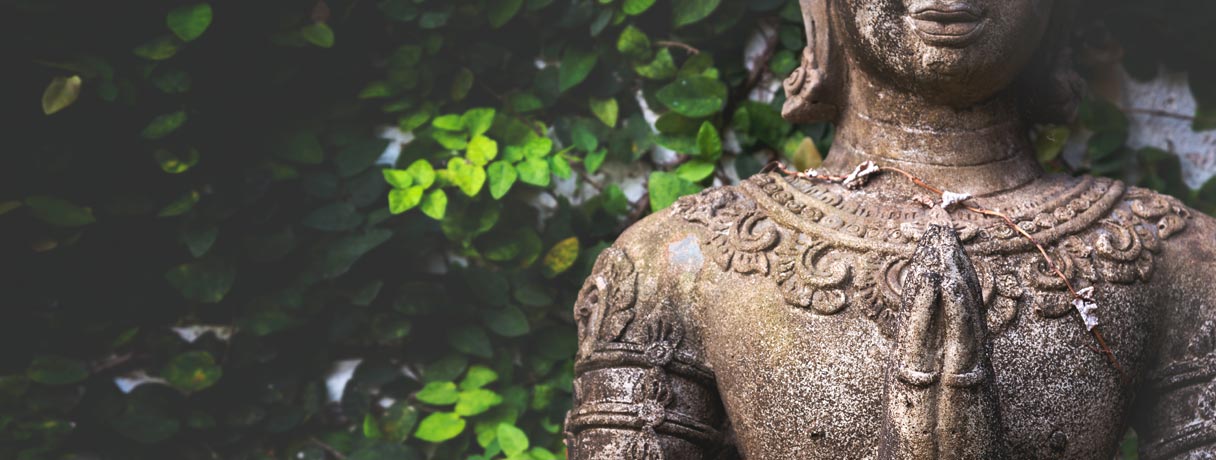
The Kriya Yoga of Patanjali
18 October 2015
The three purificatory actions of yoga are inner discipline, self-study, and surrender. When practised, the obstacles are removed and we experience clear perception.’ ~ Patanjali 2: 1-2
Commentators have observed that Patanjali’s yoga sutra was composed for several different types of student. Part 1 is for the naturally very gifted yogi. Part 2 is for students who must do some practice: with ‘Kriya' yoga for beginners & householders with limited time, and ‘Ashtanga’ (eight-limbed) yoga for full-time yogis. Parts 3 and 4 are for experienced practitioners.
It's fair to assume that most of us need to do some practice. We may not all have the time to practice Patanjali’s ashtanga yoga so the kriya yoga at the beginning of part 2 is an accessible way to start.
Yoga is the calming of the busy mind. A ‘Kriya’ is an action that frees us from the physical & mental impurities that impede our experience of calmness. Patanjali identifies three observances as being vital to progress: tapas, svadhyaya, and Ishwara pranidhana.
Tapas is the development of self-discipline. When we transcend our own, self-imposed limitations in the pursuit of a higher goal then this is tapas. For example, if I resolve that I’m going to get up every morning at 5 am and meditate for 30 minutes, at some point my mind or body, or both will rebel: surely it is much easier to stay in bed and rest. However, when I override these impulses, when I get up and do the practice anyway - this is tapas. Tapas is a fire that burns and cleanses us of sloth, ineptitude and negativity. Many Natha yogis in India make tapas their main practice with some performing extreme feats of endurance in the pursuit of siddhis - powers. I like to think of tapas as the development of willpower. When we build willpower we become stronger and more powerful. In time, we can achieve things that may once have seemed impossible.
Svadhyaya is usually interpreted as ‘self-study’. That study could take the form of reading spiritual texts: like the Bhagavad Gita or the Yoga Sutra. It could also take the form of deep enquiry into the nature of the self: asking big questions like ‘who am I?’ For some, svadhyaya takes the form of reciting mantras. All of these practices are signposts that point in the same inward direction: they encourage us to reflect deeply upon our own essential, eternal nature.
Ishwara Pranidhana means surrendering ourselves to the ‘Ishwara’ - the highest. Patanjali doesn’t specify the nature of the highest - making the practice accessible to atheists and non-atheists alike. To some, Ishwara means God, in whichever form their belief system interprets That concept. For others, who don’t have a faith, it may be a recognition of the infinite magnitude of the universe. When faced with the raw power of nature: the view from a mountain peak, the waves crashing in a storm, or a beautiful sunset on the beach; we are humbled and experience a sense of being a part of something much greater than ourselves. This is Pranidhana - surrender. When we acknowledge our relative smallness in relation to the whole, we begin to let go of our ego and our self-importance. In so doing, we experience a greater sense of connection with the whole.
Patanjali tells us that if we practice these three components of kriya yoga then obstacles will be overcome and we will experience Samadhi - clear perception. Our consciousness will be purified and we will experience new clarity. Yoga is the transformation of a distracted mind into a focused mind. Kriyas are the transformative actions that clear the way: ridding us of mental as well as physical detritus so that we can experience greater happiness and well-being.
A simple way to begin practising kriya yoga is to set aside a little time each day to walk in nature. If you live in a city it could be a circuit of the local park on the way to work. The commitment to do the walk and to physically move builds tapas. During the walk, we can chant a mantra or reflect on the self - svadhyaya. All the while, we are absorbed in nature, surrendering to Ishwara - the highest. In this way, it is possible for even the busiest person to integrate yoga into their daily routine and to have an experience of samadhi.
Hari Om
James Russell
Like this article?
Then why not share it with others who may enjoy reading it too:
Buy me a cuppa!
I hope you've enjoyed reading my blog. Perhaps you've learnt something new about yoga or its helped you with your own research and studies. Please help support my work and keep this website running.
